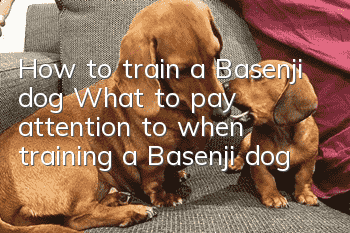How to train a Basenji dog What to pay attention to when training a Basenji dog

How to train a Basenji? When training a dog, it is more important to master the correct method than to spend a lot of time. Therefore, when training a dog, you must pay attention to some common problems and use the correct method to achieve twice the result with half the effort. .
1. First establishing an affinity relationship between the dog and its owner is the basic condition to ensure the success of dog training. For a newly purchased dog, the new owner should take the initiative to establish an affinity with the dog. Initially, the dog should get used to his family and surrounding environment. The new owner should get closer to the dog, pet the dog more, and establish a good relationship with the dog.
When teasing a dog, you should be kind, have a docile temperament, and behave normally. Don't shout loudly. Some dogs may be slow to change their feelings, so don't be too impatient and be patient. Training should be done step by step, from simple to complex. The most important thing is to have clear rewards and punishments, so as to bring punishment and motivation to the dog. Train the dog with affection, so that the dog will bring you joy, joy and satisfaction.
2. Use correct methods during training. Rewards are an important means for successful training, but the correct means of rewards mainly include giving the "good" command, petting and food rewards. Among them, "good" passwords are the best way to reward. It has the advantages of being direct, simple, fast, and effective.
Of course, the dog does not understand that "good" means approval. This requires the dog to establish a conditioned reflex for the "good" command. That is, after giving the "good" command, it should be rewarded with food immediately, and the "good" command should be given to the dog immediately. "Good" is associated with reward food. By training repeatedly in this way, the dog can establish a conditioned reflex to the "good" command.
When using "good" passwords, be sure to use them appropriately and not abuse them. When the dog performs a behavior or action that is satisfactory, the "good" command should be used in a timely manner to praise it. When the dog performs unsatisfactory actions, it cannot be rewarded. Only dogs trained in this way will be obedient and have a deep understanding of human nature.
When using the "good" command, you must timely and master the fire. Dogs have no thinking ability, and their neural connections are instantaneous or temporary, so rewards must be timely. Do not reward after a few minutes, as this will The dogs are confused because they don’t know why the owner suddenly rewarded them, because the correct action that originally occurred has long since disappeared. Unlike humans, they can associate things that happened before and after, so it is difficult to achieve the purpose of motivation. effect.
When using the "good" command, the host should be consistent on the inside and outside, that is, use a joyful tone and a smiling face. Natural and generous. If the owner's attitude is stiff, his voice is too high, and his expression is dull, the dog willIt will lose the benign effect of "good" passwords.
3. Sufficient training should be based on the most encouragement, but when necessary, it should still be appropriately reprimanded. Too much scolding will make the dog turn a blind eye to your punishment. If you hit the dog once or twice, it may have some effect, but too much beating and scolding will make the dog fear the owner.
4. It does not mean that the longer the training time, the better. Training requires a combination of work and rest, and avoid excessive fatigue, otherwise the dog is likely to lose interest in training, thus greatly reducing the training effect.
- Bichon Frize training tips, poop shovelers should keep them in mind!
- How to keep dogs away from body odor
- Four ways to make your Pitbull strong and powerful, tips for training Pitbulls that novices must read!
- How to deal with corneal inflammation in dogs
- Reasons for Tibetan Mastiff hair loss and common sense of care
- What food is better for Teddy to eat during menstruation?
- Which one is better, Golden Retriever or Chow Chow?
- How to treat a German Pinscher with canine distemper?
- Dog otitis externa symptoms and treatments
- How to heal a dog’s intestinal obstruction on its own



